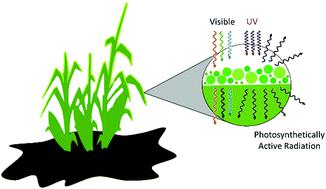当前位置:
X-MOL 学术
›
Energy Environ. Sci.
›
论文详情
Our official English website, www.x-mol.net, welcomes your feedback! (Note: you will need to create a separate account there.)
A phytophotonic approach to enhanced photosynthesis
Energy & Environmental Science ( IF 32.5 ) Pub Date : 2020-11-04 , DOI: 10.1039/d0ee02960b Larissa Y. Kunz 1, 2, 3, 4 , Petra Redekop 3, 4, 5, 6 , Donald R. Ort 4, 7, 8, 9 , Arthur R. Grossman 3, 4, 5, 6 , Matteo Cargnello 1, 2, 3, 4 , Arun Majumdar 2, 3, 4, 10
Energy & Environmental Science ( IF 32.5 ) Pub Date : 2020-11-04 , DOI: 10.1039/d0ee02960b Larissa Y. Kunz 1, 2, 3, 4 , Petra Redekop 3, 4, 5, 6 , Donald R. Ort 4, 7, 8, 9 , Arthur R. Grossman 3, 4, 5, 6 , Matteo Cargnello 1, 2, 3, 4 , Arun Majumdar 2, 3, 4, 10
Affiliation

|
Photosynthesis is the dominant biotic carbon sink on earth and hence presents an opportunity for enhanced sequestration of CO2. If the average net carbon fixation efficiency of terrestrial plants could be increased by 3.3%, all anthropogenic CO2 accumulating in the atmosphere could instead be reduced and incorporated into terrestrial biomass. Plants make inefficient use of the overly abundant sunlight available to them, a result of having evolved to be competitive and survive highly dynamic environmental conditions rather than maximize photosynthetic productivity. We explore herein a phytophotonic approach to enhanced photosynthesis, whereby sunlight is redistributed by means of luminescent or persistent luminescent (PersL) materials. Phytophotonics has potential at varied scales, ranging from photobioreactors to greenhouses all the way to crops in the field, the latter having the potential to impact planetary CO2 levels. The approach is three-fold: a spectral redistribution to relieve high-light-stress at the top surface of leaves and increasingly drive photosynthesis deeper in leaves and canopies; a minute-scale temporal redistribution to bridge periods of intermittent shade and reduce shock associated with variable light conditions; and a multiple-hour temporal redistribution to shift a fraction of high-intensity midday lighting to evening hours. Based on simulations of photoluminescent materials and light quality experiments with a model algal system, it is shown that while lengthening daylight hours will require significant improvements in PersL materials, the other two approaches show more immediate promise. We demonstrate a means of concentrating PersL light from SrAl2O4:Eu,Dy, approaching levels needed to effectively bridge periods of natural shade, and outline the scientific questions and technical hurdles remaining to realize the benefits of the proposed spectral shift.
中文翻译:

利用植物光子方法增强光合作用
光合作用是地球上主要的生物碳汇,因此为增强CO 2的固存提供了机会。如果陆地植物的平均净固碳效率能够提高3.3%,那么所有人为的CO 2相反,可以减少在大气中的积累并纳入陆地生物量。植物已经变得具有竞争力并可以在高度动态的环境条件下生存,而不是最大限度地提高光合作用的生产力,因此无法有效利用过多的阳光。我们在本文中探索一种植物光子方法来增强光合作用,从而通过发光或持久发光(PersL)材料重新分配阳光。植物光子学具有不同规模的潜力,从光生物反应器到温室,一直到田间作物,后者都有可能影响行星式CO 2水平。该方法有三方面:光谱重新分布以减轻叶片顶部表面的高光胁迫,并逐渐推动叶片和冠层中更深的光合作用;微小的时间重新分布到间歇性阴影的桥接周期,并减少与可变光照条件相关的冲击;以及数小时的时间重新分配,以将一小部分高强度的午间照明改为夜间。基于光致发光材料的模拟和模型藻类系统的光质量实验,结果表明,延长日光时间将需要对PersL材料进行重大改进,而其他两种方法则显示出更直接的希望。我们展示了一种从SrAl 2 O 4聚集PersL光的方法:Eu,Dy,接近有效桥接自然阴影周期所需的水平,并概述了剩余的科学问题和技术障碍,以实现拟议频谱偏移的好处。
更新日期:2020-11-13
中文翻译:

利用植物光子方法增强光合作用
光合作用是地球上主要的生物碳汇,因此为增强CO 2的固存提供了机会。如果陆地植物的平均净固碳效率能够提高3.3%,那么所有人为的CO 2相反,可以减少在大气中的积累并纳入陆地生物量。植物已经变得具有竞争力并可以在高度动态的环境条件下生存,而不是最大限度地提高光合作用的生产力,因此无法有效利用过多的阳光。我们在本文中探索一种植物光子方法来增强光合作用,从而通过发光或持久发光(PersL)材料重新分配阳光。植物光子学具有不同规模的潜力,从光生物反应器到温室,一直到田间作物,后者都有可能影响行星式CO 2水平。该方法有三方面:光谱重新分布以减轻叶片顶部表面的高光胁迫,并逐渐推动叶片和冠层中更深的光合作用;微小的时间重新分布到间歇性阴影的桥接周期,并减少与可变光照条件相关的冲击;以及数小时的时间重新分配,以将一小部分高强度的午间照明改为夜间。基于光致发光材料的模拟和模型藻类系统的光质量实验,结果表明,延长日光时间将需要对PersL材料进行重大改进,而其他两种方法则显示出更直接的希望。我们展示了一种从SrAl 2 O 4聚集PersL光的方法:Eu,Dy,接近有效桥接自然阴影周期所需的水平,并概述了剩余的科学问题和技术障碍,以实现拟议频谱偏移的好处。



























 京公网安备 11010802027423号
京公网安备 11010802027423号